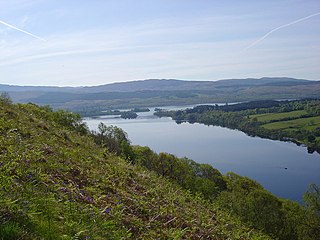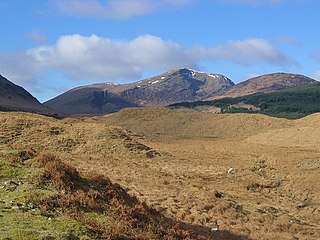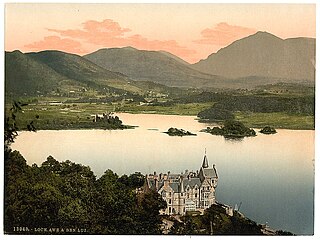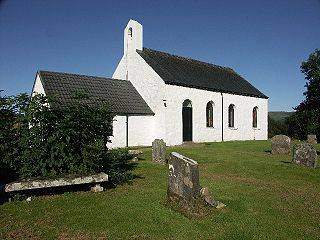
Clan Campbell is a Highland Scottish clan. Historically one of the largest and most powerful of the Highland clans, their lands were in Argyll and the chief of the clan became the Earl and later Duke of Argyll.

Menteith or Monteith, a district of south Perthshire, Scotland, roughly comprises the territory between the Teith and the Forth. Earlier forms of its name include Meneted, Maneteth and Meneteth.

Loch Awe is a large body of mostly freshwater in Argyll and Bute, Scottish Highlands. It has also given its name to a village on its banks, variously known as Loch Awe or Lochawe. There are islands within the loch such as Innis Chonnell and Inishail.

Clan Macnaghten is a Scottish clan.
Gogarloch is a residential area within South Gyle, Edinburgh, Scotland. It lies near South Gyle railway station and South Gyle Broadway, 4+1⁄2 miles (7.2 km) west of the city centre. Corstorphine and Wester Broom are nearby.

Loch Awe railway station is a railway station serving the village of Lochawe, on the northern bank of Loch Awe, in western Scotland. This station is on the Oban branch of the West Highland Line, originally part of the Callander and Oban Railway.
Cailean Mór Caimbeul is one of the earliest attested members of Clan Campbell and an important ancestor figure of the later medieval Earls of Argyll.

The Battle of the Pass of Brander in Scotland forms a small part of the wider struggle known as the Wars of Scottish Independence, and a large part of the civil war between the Bruce and Balliol factions, a parallel and overlapping conflict. It was a victory for King Robert the Bruce over the MacDougalls of Argyll, kinsmen of John Comyn, also known as the Red Comyn, who had been murdered by Bruce and his adherents at Dumfries in 1306. The sources do not allow us to determine the date of the battle with any degree of precision: various dates between 1308 and 1309 have been suggested, though the late summer of 1308 would seem to be the most likely. Traquair dates it to August 1308.

The Battle of Dalrigh, also known as the Battle of Dail Righ, Battle of Dalry or Battle of Strathfillan, was fought in 1306 between the army of King Robert the Bruce against Clan MacDougall of Argyll, who were allies of Clan Comyn and the English. It took place at the hamlet of Dalrigh near Tyndrum in Perthshire, Scotland. Bruce's army, reeling westwards after defeat by the English on 19 June at the Battle of Methven, was intercepted and all but destroyed, with Bruce himself narrowly escaping capture. The battle took place sometime between July and early August, but the exact date is unknown.

Taynuilt is a large village in Argyll and Bute, Scotland located at the western entrance to the narrow Pass of Brander.
The Bridge of Awe was a triple-spanned arch bridge near Taynuilt in Argyll, Scotland.
The Pass of Brander stone signals, also known as Anderson's Piano, are a series of railway signals situated in the Pass of Brander, between Loch Awe and Taynuilt stations on the Oban branch of the West Highland Line in Scotland. A screen of wires, linked to semaphore signals, are erected on the mountainside alongside the railway. In the event of one or more wires being broken, signals in each direction are automatically placed at 'danger'. They are part of a warning system that advises train drivers to exercise caution in the event of a rock-fall, and cover a section of track that is just over 4 miles (6.4 km) in length.
John of Argyll, was a Scottish nobleman of the early 14th century. He is often known to today as John Bacach, "the Lame", but there is no authority for that as a contemporary or near-contemporary nickname.

Innischonnell is an island in Loch Awe, Scotland. It is part of Kilchrenan and Dalavich parish, in Argyll. The island is fourteen miles east of Kilmartin, Argyll.

Inishail is an island and former parish, in Loch Awe, Scotland.

Ben Bhuidhe is a Scottish mountain at the head of Loch Fyne, Argyll and Bute.

Dalavich Church is a kirk (church) in the settlement of Dalavich in the Lorne district of Argyll in Scotland, belonging to the Church of Scotland. It is situated 14.0 miles (22.5 km) south of Taynuilt and 7.0 miles (11.3 km) south–west of Kilchrenan on the B845 road on the western shore of Loch Awe.
Fraoch Eilean/Ejlean is a small island situated at the northern end of Loch Awe, a freshwater lake in Argyll and Bute, Scotland. It is notable for being the site of a medieval royal castle, now ruined, which was given into the keeping of Clan Macnaghten by Alexander III in 1267.

The River Awe is a short river in the Southwest Highlands of Scotland by which the freshwater Loch Awe empties into Loch Etive, a sea loch. The river flows from a barrage which stretches across the end of a deep arm of the loch which protrudes northwestward through the Pass of Brander from the northeast–southwest aligned Loch Awe. The river is accompanied for much of its length both by the railway from Glasgow to Oban and by the A85 road both of which cross the river halfway along its length. The Awe is also crossed by a minor road bridge and a foot bridge.

The River Orchy is a river that passes through the village of Dalmally, Argyll in the West Highlands of Scotland. It rises in the Black Mount Forest, and flows southerly, passing through Loch Tulla and Glen Orchy before reaching Loch Awe. The hills of Beinn Mhic-Mhonaidh, Beinn Udlaidh and Beinn Bhreac-liath are to the north and south; there are falls and islands within the river. Reachable by the A82 road, tourists partake in kayaking, whitewater rafting, and fishing. Recent gold mining exploration has occurred in one of the river's glens just outside the Loch Lomond and The Trossachs National Park.















